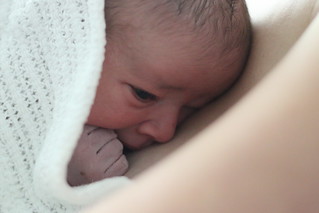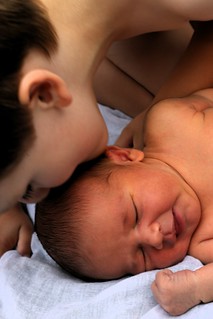I promised a friend I would answer this question: What do you spend all that time on, when you have a newborn?
Let me start with my general philosophy of learning to baby parent, which is to read people’s baby parenting blogs. Especially really funny, wise or kind people. For example, you could do worse than read… basically Julia’s entire blog, or Rivka’s blog from the start of her first, second or third pregnancies (warning: the second one miscarried). Or Yatima’s birth story.
Something I was told a lot before I had babies was that nothing prepares you for what it is like, and actually, I didn’t find that to be so. Mothers’ stories prepared me for what it is like. Plus, great writing.
The other very useful thing I did was to attend a private birth and early parenting course taught by Renee Adair of the Australian Doula College and specifically for the purposes of this entry she drew a clock face covering 24 hours, marked out (provisionally) the time between 1am and 5am as “hopefully baby’s long sleep if you’re lucky”, and divided the rest up into three hour chunks: nursing and baby care, baby sleeps. Three hours is up, start again. And that’s the first six to twelve weeks of a baby’s life.
Spending a couple of days or more in a birth/baby care class can be worth it, I think.
The major mistake I made was knowing so much about the early weeks of a baby’s life that I didn’t realise that this phase is temporary and so instead of checking out of life to the extent that I would have been allowed, I forced myself to be out of the house walking around and doing errands and such because this is the new normal, princess. (Spoiler: no it isn’t, older babies are really different.)
Note that I am only covering things that happened to me in this entry. So there’s, eg, no pumping or otherwise trying to bring up a low milk supply, because my problem was oversupply rather than under. There’s no prematurity care, or post-Caesarean recovery. Do read more than one story.
Nursing
Damn, this took up some time. It is worth noting that my feeding sessions were a lot faster than many mothers. A newborn can feed for an hour in many mother-baby relationships, rather than my babies’ five to fifteen minutes of hovering by the milk jetstream.
Learning to breastfeed. My babies had the rooting and suckling instincts at birth, but that’s not the same as being able to pop them on and wander around freely first thing. There’s a lot of looking and fiddling and puzzling over positions.
Dealing with the pain of breastfeeding. The first two weeks of nursing my first baby were painful. Me nursing involved getting my husband to be nearby and applying pain to some other part of my body to distract me, and hissing as I felt my nipple go stretch-stretch-stretch until it was sucked into place.
Second baby didn’t hurt, but I spent some time anticipating that it would!
Breastfeeding in low light. Newborns can’t hold their heads up. So breastfeeding them at all involved holding their head in the vicinity of a nipple, and doing so in low light meant squinting or feeling for their mouths and my nipple and trying to line them up in the dark.
My babies have both slept in my bedroom and I learned to nurse them lying down after a few nights with the elder. That skill is WIN.
Cluster feeding. Days when suddenly, the feeds have five minute breaks in between because the baby is trying to gain 300g or more in a week.
Stupid oversupply routines. The undersupply ones are worse, but the oversupply one ended up at: apply warm press to aid let down, express a small amount so that the nipple is soft for the baby, nurse (complete with the pain management rituals), apply cold press to reduce inflammation. Only for a day or two, but that’s a big routine.
Having mastitis. I had mastitis when my elder baby was five days old, probably because I had the milk supply of a quadruplet mother. It was 40°C or so, my thighs hurt in the morning (this is a really reliable sign in me that I’m about to develop a 40°C fever), I woke my husband in the middle of the night to say that I had gone through a 24 hour allowance of both paracetemol and ibuprofen in 18 hours and I didn’t know if I could make it until morning. Neither did the health hotline; they were worried about infection in my stitches. We called one of the night GP services and they diagnosed mastitis and I spent a fortnight on antibiotics without further incident, but gosh that was a terrible 48 hours. If you’ve ever had influenza, well, like that.
Being puked on. One problem with oversupply was that my newborns would sometimes belch slightly and then start helplessly overflowing like boiling-over saucepans. So in addition to carrying floppy babies around awkwardly, we would always have towels draped on ourselves for hurried protection. It didn’t seem painful for them though. It was annoying with my elder, as he’d completely empty his stomach by doing it and then cry urgently for more milk, which demand had the effect of increasing my supply even further. No love.
Baby care
Cuddling. My newborns liked to be held, and newborns are really floppy and fragile. So there was a lot of gingerly moving around discovering that I am used to having two hands to do things. (I didn’t find baby carriers super helpful for my hands until the baby had some muscle tone, which is the same point at which they are easier to carry anyway. What was useful with baby carriers was just getting used to carrying the baby’s weight before the baby gained its first 2kg, that first 2kg taking my first baby a whole six weeks.)
Cuddling for hours before sleep. Only one of my babies needed this, but he peaked one night at needing five hours lying down with me in a completely dark room while screaming, in order to sleep. That is some cuddling!
The other baby used to be put down on a flat surface and just go to sleep. We spent the entire newborn period just waiting for her to stop doing that and being prepared. (She has had periods of having trouble with sleep, but not at the age I’m talking about here.)
Changing nappies. Something I wasn’t warned about: nappy changes. For several weeks after birth, both my babies pooped after every single breastfeed, so, maybe 12 times a day. Pick up the baby. Walk to the change area. Get a nappy. Take off the existing nappy. Put a new one on. Take the baby back to whereever I wanted to be. Around about twice a day, I also needed to wipe down and change the outfit on a baby that had pooped through the nappy onto its clothes.
Gosh it’s nice to go down to every three or four hours and an all-night nappy. (On the flipside, newborns don’t move around…)
Keeping the baby cool. This was a whole project with my first, who was born in a heat wave. Newborns have shitty temperature regulation, don’t really sweat, and on top of it all, get kinda sleepy when they’re hot and don’t necessarily feed well. We were wiping him down and spraying him here and there.
Self-care
Birth recovery. I felt amaaaazing after my second birth (allowing for an hour’s lie-down and a shower), because the active labour and birth were very fast (90 minutes all up), and wheeee not pregnant now I can breathe again. (Until later in the day when I remembered that I’d been in early labour for most of the night instead of sleeping, and I slept so hard that night I kept forgetting to put the wee baby back in her bed and leaving her asleep between me and the toddler.)
But I haemorrhaged after my first birth and my iron levels fell by about a third. Walking at all was a bit of a challenge, and it didn’t help getting mastitis within the week. I did this super-hard thing — late pregnancy and birth — and as a reward, I got to be sick, tired and weak while parenting a newborn.
The actual process of recovery was resting and iron tablets, but unfortunately not enough…
Sleep. My second baby was a sort of miracle and slept to the point where we haven’t had serious sleep deprivation issues. The first though was more typical after his jaundice disappeared: no more than three to four hours of continuous sleep, sometimes hour long wakings in the night. So there was time spent asleep, there was time spent planning sleep, there was time spent missing sleep. There was that time the baby was crying in the night and I dreamed that he was telling me telepathically that he was actually OK and in was no way hungry or otherwise needing me. And of course, eventually waking up and realising I was wrong.
Dressing. I didn’t really properly dress after the first baby for¸ uh, a couple of weeks. I feel kinder to myself now that I remember the mastitis and the haemorrhage and the heat-wave though.
Recording TV and reading stuff on devices. Digital video recording, e-book readers and smartphones saved me. You know how many interesting books are kinda heavy and hard to hold one handed? Well, they were also very painful for the baby when I dropped them.
Cleaning
Laundry. This was the big one. Stuff we needed to wash:
- nappies (we use cloth), 3–4 loads a week with a newborn
- baby outfits that had been wee-ed or pooped or vomited on, actually not many loads as babies and their clothes are both small!
- our outfits that had been wee-ed or pooped or vomited on, I guess about 2 loads a week
- bedding. One million trillion loads a week, because I leaked milk like no one’s business, especially with the second baby who always had a long night sleep. I would wake up on top of three soaked towels and soaked sheets, so I was washing a king sized bed worth of linen most days for weeks and weeks with this second baby. (Pro-tip: waterproof mattress protector. My first newborn parenting experience ruined a mattress with leaked milk. Note though: you get to wash the protector too!)
Other cleaning I have had a house cleaner since my first pregnancy, so not as much of this as one might fear, but, lucky me.
Cooking My husband took over the bulk of our meal prep. (He did a lot of the laundry too.)
Leaving the house
Suddenly, we needed to leave a full hour between deciding to leave the house and actually leaving it, what with packing a bag, and changing a nappy, and then probably changing it again, and a feed, and someone getting puked on and needing to be changed.
And, unlike most other things in this entry, this hasn’t really gone away. 5 year olds are still a pain to get out of the house, it’s just different reasons why.
Medical followup
Newborns are medically fragile in a way that I’m glad I didn’t really appreciate at the time: they can’t regulate their body temperature for a few days, and their immune systems don’t work well for weeks. Luckily my babies were good nursers, but there was still:
Counting nursing sessions and urine and poop. The first time, I didn’t actually know I was supposed to do this until I had annoyed midwives around me in hospital wanting to fill in the chart, and it only lasted for a few days, but still. What time did the baby start nursing? How long for? Were the nappies wet? Any meconium? Any later stage poops? (There’s a pictorial chart that anyone who has anything to do with the Australian Breastfeeding Association has seen.)
The second time I was super organised and had a whole notetaking system set up, and then my milk again came in within 24 hours and we graduated from poop counting at two days old.
Three days in hospital after my first. He had jaundice they wanted to monitor.
Daily home visits after my second. Standard practice for my private midwife to do this for a week. It was nice, really, and she ended up skipping a few, but it was still something I had to set aside time for.
Longer term followup/cleanup for me. After my first, I had two and six week appointments, and also a renal physician followup. After my second, I had midwife followup at two, three and six weeks, and then a GP and gynaecologist (for an IUD).
The pregnancy treadmill of endless appointments continued for a little while, except I had to take a giant bag of nappies and outfit changes and feeding supplies and miscellaneous cleaning products with me. The first time it was inevitably at the one time of day I and my newborn both wanted to sleep. The second time I had a nearly 4yo child, so we were more on a day-night schedule straight away, and so it was actually less hassle.
Longer term followup for babies. Both had a two and six week weigh-in and developmental exam (I remember my elder howling as he “walked” along a table). There was also a vaccination at six to eight weeks. (Not to mention the ones at four and six months — basically, vaccinate early and often.)
In summary
Newborn care — even in my case of healthy late/post term high birthweight and milk-stuffed babies — is a full time job, ideally for more than one person if you have arrangements or can make them… Andrew took two weeks off after the was born and then worked part-time for another twelve or so weeks after, and took six weeks off full-time after the second was born. Epically great.








